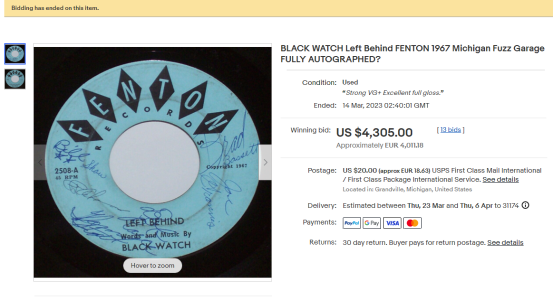In 1970 when I started seriously collecting records, as opposed to buying new releases, the rockabilly scene was populated almost exclusively by 20-30 year old working class European males. In those days there was precious little knowledge about relative rarity and next to no label discographies. Word of mouth and primitive fanzines were our sources of information. A few intrepid souls like Dan Coffey and Charlie Barbat, had travelled to the US and returned with boxes of 45s dug out of warehouses, the back rooms of record stores and jukebox distributors. None of us knew how many or how few copies of these discs existed, so there was no 'official' price on most of them. The customer base's disposable income largely dictated the price (Capitalism in action!) Here's an example:
Four x 25 boxes of Carl Mann's 'Gonna Rock and Roll Tonite' were discovered and sold for £1 each. There were enough to go round and most of those who wanted it got a copy. Thus it was seen to be 'common'. It was the same with Benny Joy/Dixie, Lynn Pratt/Hornet, Billy Wayne/Hillcrest and other great records. In all likelihood these copies were the only mint ones in existence, but at the time no one was aware of this. Then, around 1972, some higher income players entered the scene. These characters were from the professional class; barristers, bankers, stockbrokers, the offspring of wealthy parents, etc. Suddenly, prices went north at a rapid pace. The standard was $200 for a sought after disc, even if it was part of a bulk find.
By the late eighties things had settled out a bit, but the prices of top class rockabilly 45s remained high. From memory the first $1k 45 was sold in 1985; Hi Tombs 'Sweet Rockin' Mama'. A mint copy. For contrast, I bought a mint Starfires 'Linda' for $10 in 1985.
Nowadays there are probably less people collecting original rockabilly 45s and the price of many relativelycommon pieces has stagnated or dropped from the halcyon times. Nevertheless the top drawer items in fine condition still fetch high prices. One of the reasons for this is scarcity of vg++ and above examples. This is mainly due to the fact that records from those early bulk finds were played on very inferior equipment - those stand alone record players with sapphire styluses that every home had back then. Some years ago the son of a recently deceased collector who I had known from those days offered me first dibs on his dad's collection. Some fine rarities for sure, but all of them had been tortured to death by various crap needles, rendering the collection just about worthless.
Given the common recurrence of events, it seems likely that 60s teenbeat collecting will follow a not too dissimilar path. The bubble may well fracture, but not burst entirely.
There's another paradox associated with this tale, but I've bored you enough for one day.



